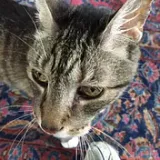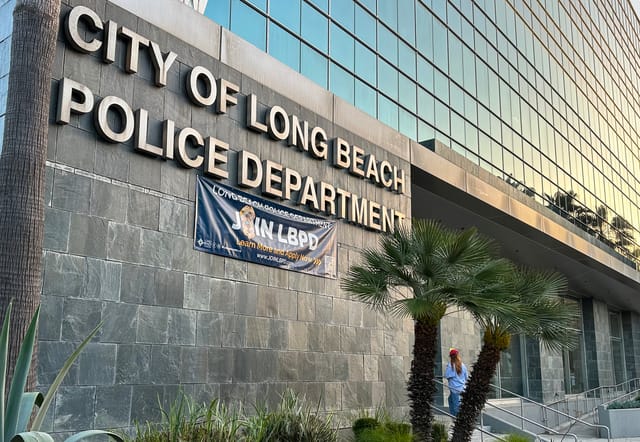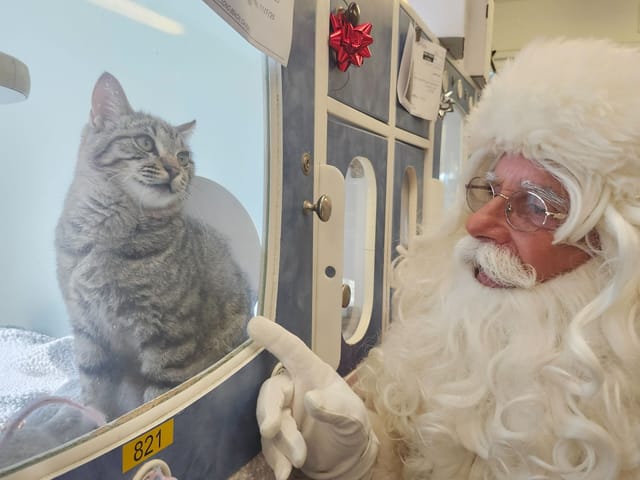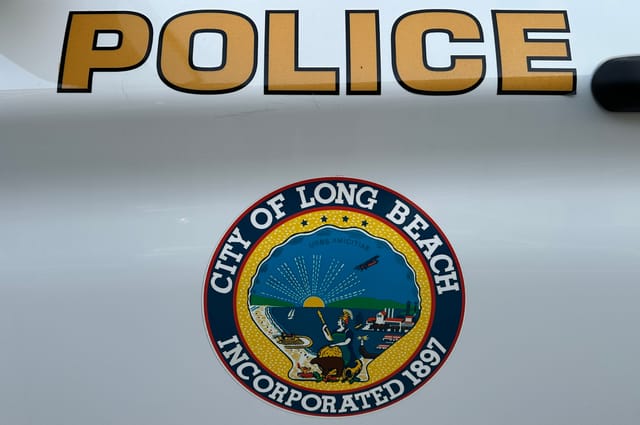Mitigating the kitten flow!
A partnership among three Long Beach animal organizations spays and neuters 156 cats in a month.
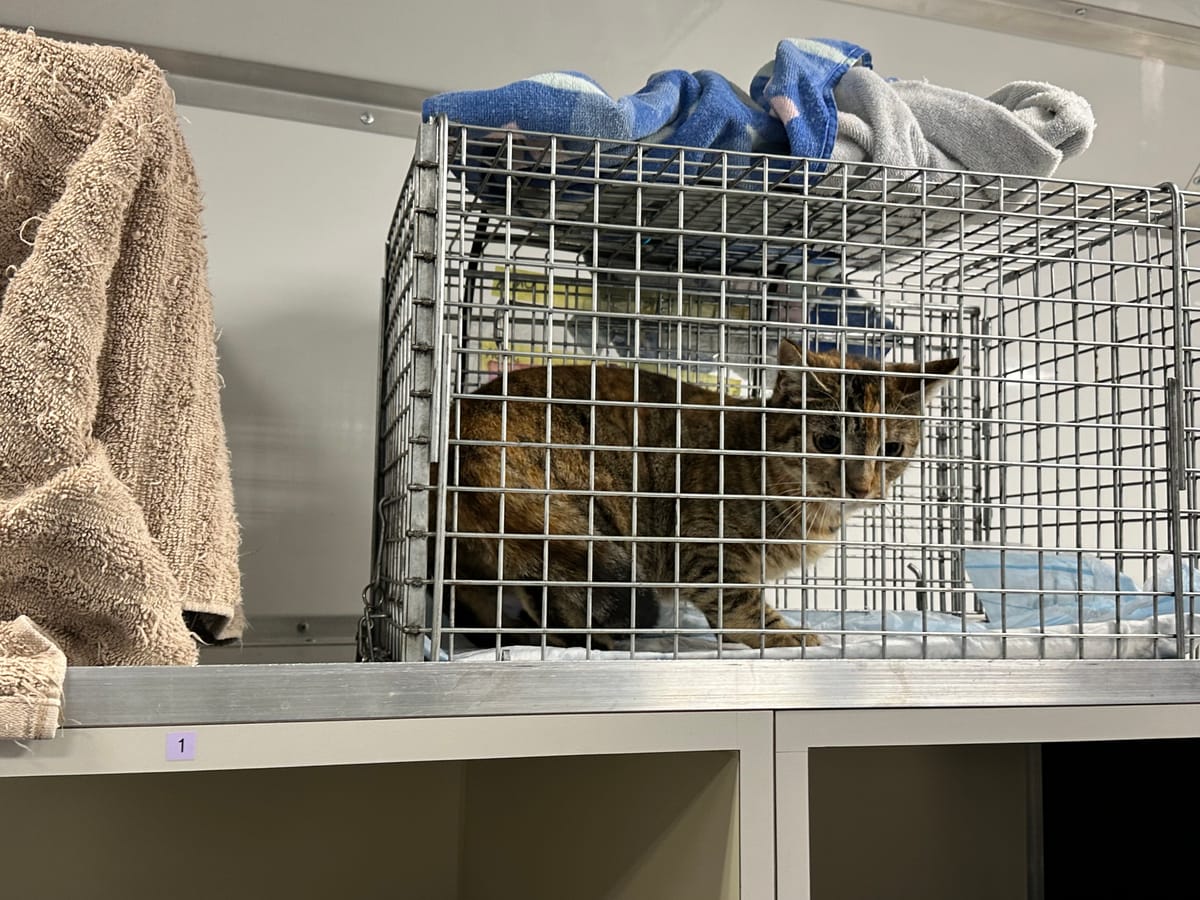
Kitten season is crouching right around the corner, ready to pounce. That sounds cute, and kittens are certainly cute, but what ”kitten season” really means is a birth rate tsunami brought on by unaltered community cats — felines who live outdoors and have no known owners. Those kittens are born only to die on the streets or in shelters, or live long enough to give birth to more kittens, which a female cat can do at only 4 months old.
Here in Long Beach, a city of animal lovers and advocates, a conflation of caring and enthusiasm has been holding back the tide of unwanted kittens in streets, backyards and alleys. TNR volunteers, rescues, animal organizations, our shelter at Long Beach Animal Care Services and an increasing number of residents are helping to reduce the population of community cats. During January, in a partnership with LBACS, Helen Sanders CatPAWS organized a series of spay/neuter clinics focusing on a TNR effort for targeted community cat colonies in the Long Beach area.
“We are grateful for the opportunity to get ahead of the upcoming onslaught of unwanted litters,” said Deborah Felin-Magaldi, cofounder of Helen Sanders CatPAWS. “We have one more clinic to go.”
The monthlong effort takes place one day a week on shelter grounds. On Jan. 27, the next-to-last clinic, CAMP (Community Animal Medical Project) brought its own mobile clinic to boost the effort. The two organizations hoped to fix 75 cats in all that day, but even with the rain hampering some of the trapping efforts, 52 cats — 25 from CatPAWS and 27 from CAMP — got fixed and will no longer birth kittens. And the kittens that didn’t get born won’t birth any kittens. And so on.
“Thousands!” said Adrian Perez, CAMP’s director of operations, when asked for an exponential estimate of how many births were prevented.
After next week’s final clinic, the number of fixed cats will total 156, including the ones from Monday’s CAMP clinic. Tens of thousands, Adrian!
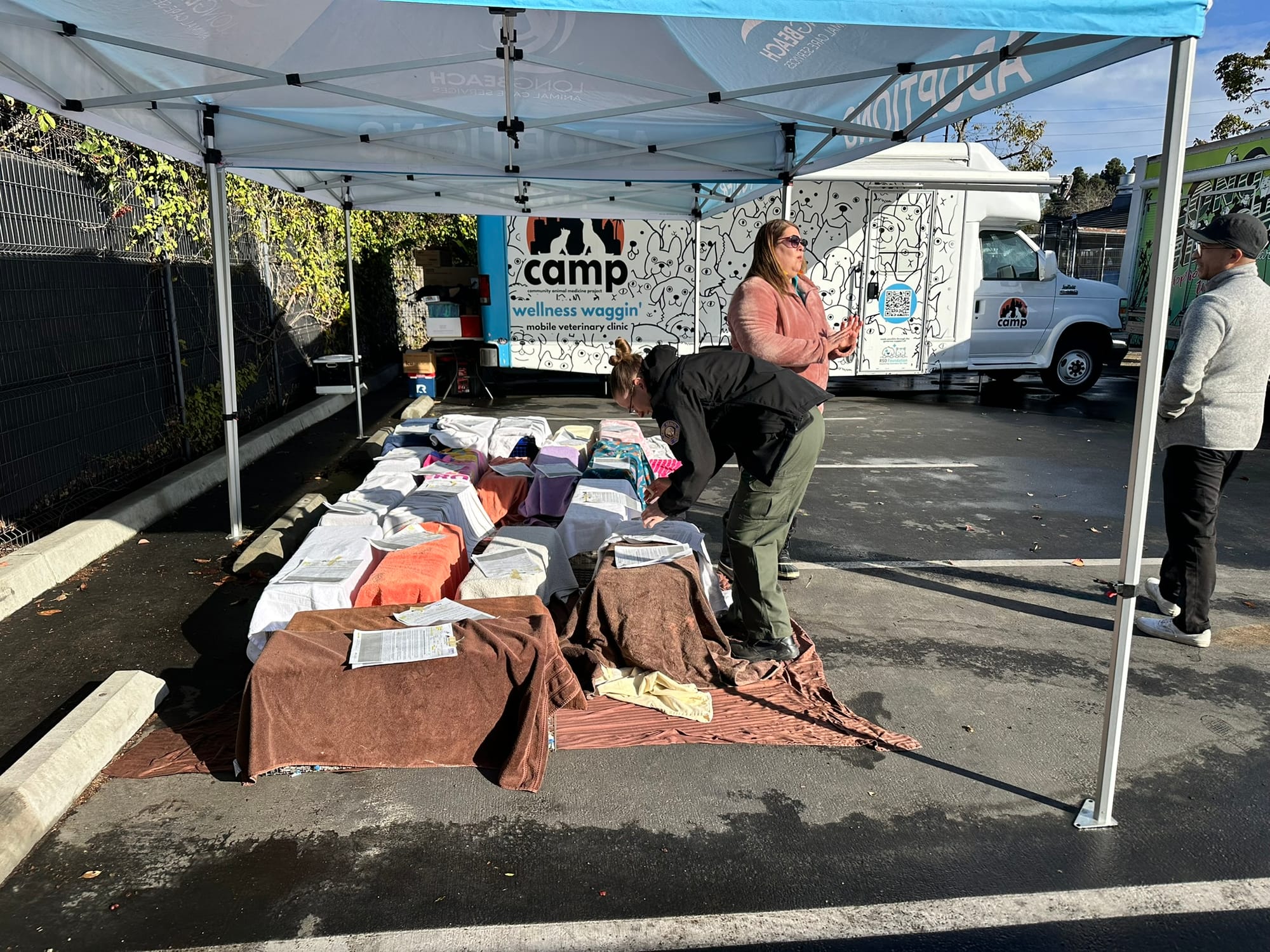
“This is the culmination of a monthlong fix effort,” said Lance Smith, kick-butt factotum of the CatPAWS team. “We’re focusing on entire colonies — we got one of eight and one of 19. Individual volunteer trappers did the trapping, and the homeowners were doing the caregiving, like feeding and so on. I give credit to LBACS for partnering with everyone.”
The logistics for TNR clinics need to run like a well-sardine-oiled machine: The trapper or colony caretaker fills out an application. CatPAWS team member Julie Somers contacts the applicants and assesses how the colonies are cared for. Somers makes appointments and logs them in to the system. A day or two before the surgery, feeders for the targeted colonies withhold food from the kitties. That way, they’ll be good and hungry and will go for the sardines and other stinky food in the traps.
“The goal is to trap all of them — the cats can get trap savvy, and we don’t want to have to come back [to the colony],” Somers said. “It’s usually a two-day process, so if the cats that don’t want to go into the trap the first day are reeeallly hungry, they’ll go in the second day.”
The day before the clinic, experienced TNR volunteers set up their traps near the colonies. When the cats are trapped, they’re transferred to a safe, sheltered area.
Back at the shelter, the clinic team pops bright-eyed and eager out of the sack at 4:30 a.m. and maneuvers the clinic into the shelter parking lot. Someone picks up coffee.
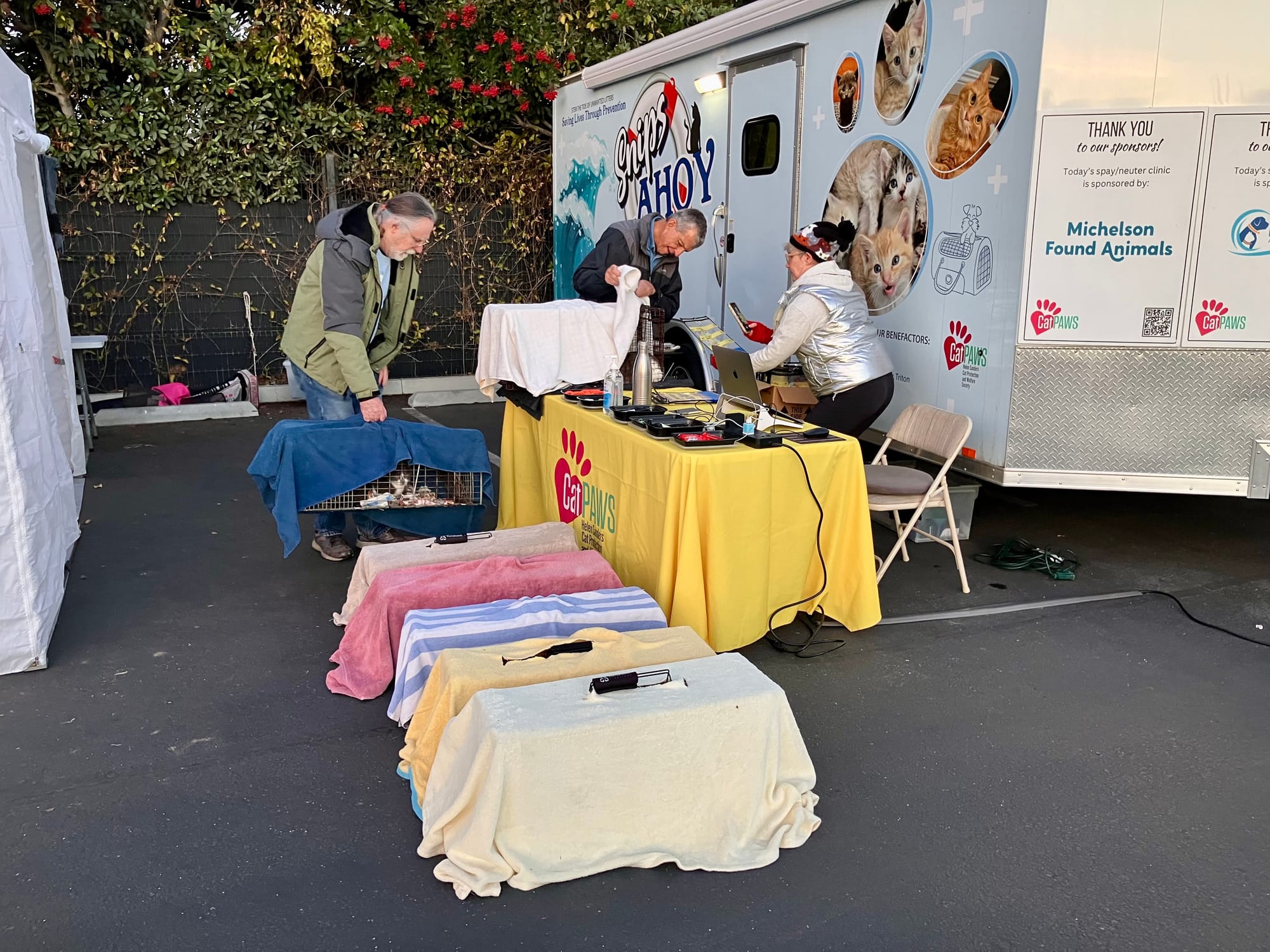
“You know the way you see little kids on the soccer field? That was us this morning here!” said Lindsie Merrick, LBACS’ community cat coordinator, on Jan. 27. “We all have to double-check, sort the cats, make sure that they’re going home with the right people.”
The veterinary team — a veterinarian, a veterinary technician and a veterinary assistant — arrives and preps the cats for surgery and vaccines. During surgery, while the kitties are out cold, the tip of the left ear is removed to identify them as cats who have already been fixed.
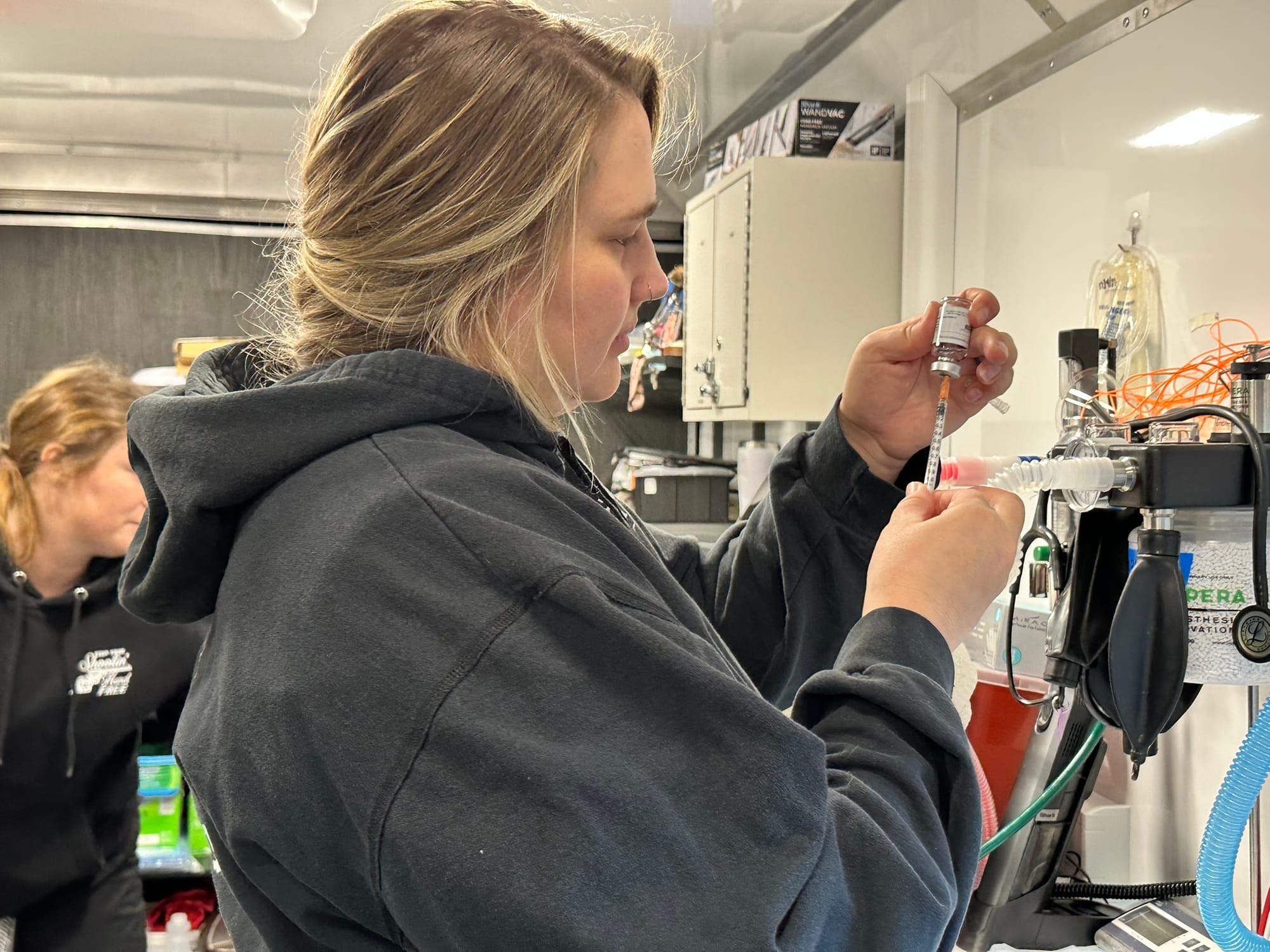
After surgery, the cats are placed back into the traps and covered with towels or blankets for privacy and warmth. The trappers return for them and keep them in a safe place, with water and a little food, for another night.
So, the “T” (trap) has been done, and the “N” (neuter, spay, vaccinate, ear-tip and whatever medical attention is necessary) is successfully completed. Now, it’s time for the “R” part of TNR — return. The trappers take the cats in their traps to their colonies and let them out. If all has been successful, the cat colonies are now feline retirement communities. If there are kittens or any friendly adult cats, efforts are made to place them with rescues, fosters or adopters.
With a few variations, that’s the general process for TNR anywhere.
Efforts such as the mobile clinics and the focus on community cats by LBACS has lightened the burden of finding spay/neuter assistance for TNR volunteers.
“I think that the mobile clinic is sorely needed,” said John Crouch, who assists Smith at all the CatPAWS clinics and does a lot of trapping himself. “What’s always been a problem with trap/neuter/return are the appointments. Now, you have pretty consistent appointments, and not only that, there are other places that are starting to come onboard with it. Pretty amazing development in Long Beach — we are unique.”
If you worry about the cats living outside and giving birth to kittens that may not make it in any case, or if you’re on the other side of the kitty coin and wish they’d all just get the heck out of your yard, the TNR stakeholders invite you to join up and lend a paw to the effort.
“A lot of people don’t believe they can do it themselves, but they can,” Merrick said. “We have all the resources to teach them how easy it can be. I would love for them to contact us so they can get involved and help their neighborhood cats.”
Coordinate with the Community Cat Coordinator at Lindsie.Merrick@longbeach.gov.
Come to the Long Beach TNR and Community Cat Coalition meeting on Saturday, March 1, 11 am–1 pm. at the Education Center at Long Beach Animal Care Services, 7700 E. Spring St. (at entrance to El Dorado Park — no parking fee for shelter visitors). You’ll learn about trapping methods and TNR resources, and you’ll meet people who’ll share them with you.
CAMP regularly offers low-cost wellness clinics for cats and dogs at LBACS and other area locations. Access this link for the schedule.
Yours drooly
Trying to save neonatal kittens is often heartbreaking, and as often as it happens, few rescuers become used to it. The five kittens in the photos are adoptables-in-waiting—they once numbered seven, but two of them died shortly after Helen Sanders CatPAWS took the litter in.
Besides any disease potentially passed to kittens by a mother cat, fading kitten syndrome is also a cause of death in newborn kittens. It generally occurs during the first week after they’re born.
“A mother cat can get pregnant by multiple males up to 10 days max, so when she’s giving birth, they all get born, ready or not,” said CatPAWS medical team member Bev. “That’s why there’s a runt in a bunch — the ones conceived first are ripe!”
The kittens in the photos are doing great, though. They’re about a week old at this writing and were all tube-fed. A couple of them were in an oxygen exchanger, which turns normal breathing air into 90% oxygen. Both things helped to keep them alive, Bev said, and they’re now thriving with a foster. That’s what Helen Sanders CatPAWS has always done from the beginning: makes every effort for every cat born to lead a full life.
As winning as they are, you may not put dibs on any of them for future adoptions (I asked Bev and she gave a firm no). But keep an eye on the cats in the adoption center of the Seal Beach PetSmart, 12341 Seal Beach Blvd. In a little less than eight weeks, these Jazz Babies will be romping around in there. Or visit now, and play with the present residents. Most of them started out just like these newborns, and you can take a couple home and enjoy one another for the rest of their long lives.
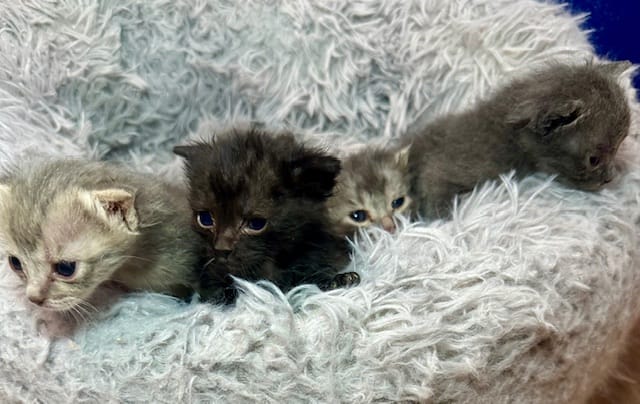
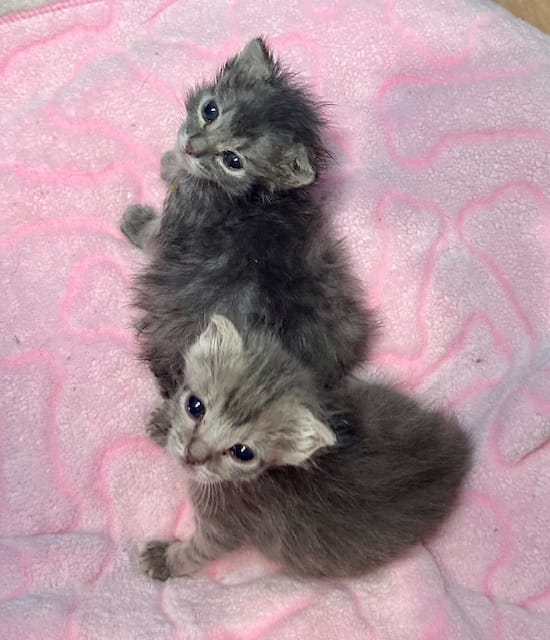
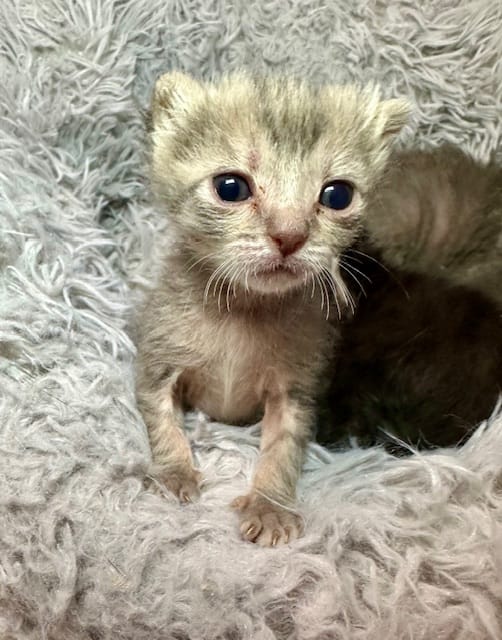
TAIL-WAGGIN' AND NOSE-BOOPIN' EVENTS
Cats & Mats Yoga
What’s better than a good, long stretch for the whole body? A massage while you’re doing the poses, best done by a kitty kneading you where you need it the most! Feline Good Social Club rolls out the mats for the new year every Monday evening starting Jan. 26. Bring a yoga mat, a towel and water; wear comfy clothing; and get ready to do downward-facing dog as the cats walk under, over and around you, facing you every way there is!
Yoga sessions take place Monday nights at 6:15 p.m., beginning Jan. 26 at Feline Good Social Club, 301 Atlantic Ave., Long Beach. Sessions are $19.99. Reservations are required; make them here.
Bob Long Memorial Mutt Run
You and your dog — or just you — are invited to raise funds for Long Beach Animal Care Services and Signal Hill Rotary’s Community Project Fund by running your legs off, however many you have. There are three races — two for humans and their dogs, and one for humans only. Nonaggressive dogs only; all dogs must be leashed for the run. Meet adorable adoptables from LBACS and K9 Kismet after the race! Sign up for any of the races here.
The Bob Long Memorial Mutt Run takes place Saturday, Feb. 1, 8:30 a.m.–11 a.m. at the Claremont boat launch ramp, 5350 E Ocean Blvd., Long Beach. Entry fee is $69.90 per person.
CatPAWS pops up at the pier!
Helen Sanders CatPAWS cat and kitten rescue will host a booth at Pop-Ups at the Pier, sponsored by the Seal Beach Chamber of Commerce. No kitties at this event, but you can ask questions about cat and kitten care for your own furry besties and also find out how you can help CatPAWS help cats without homes through fostering, adopting, volunteering and donating. A good spin of the wheel can win you a fun prize! The event coincides with a three-day sidewalk sale on Main Street.
Pop-Ups at the Pier takes place Saturday, Feb. 1, 11 a.m.–3 p.m. at Eisenhower Park at the Seal Beach Pier, Ocean Avenue and Main Street, Seal Beach. Free event.
Need a low-cost veterinarian, information about trapping community cats, places to volunteer, rescues and shelters to adopt from — anything pet related? Follow this link for resources. Please add your own ideas in the Comments section.
We need your support.
Subcribe to the Watchdog today.
The Long Beach Watchdog is owned by journalists, and paid for by readers like you. If independent, local reporting like the story you just read is important to you, support our work by becoming a subscriber.

